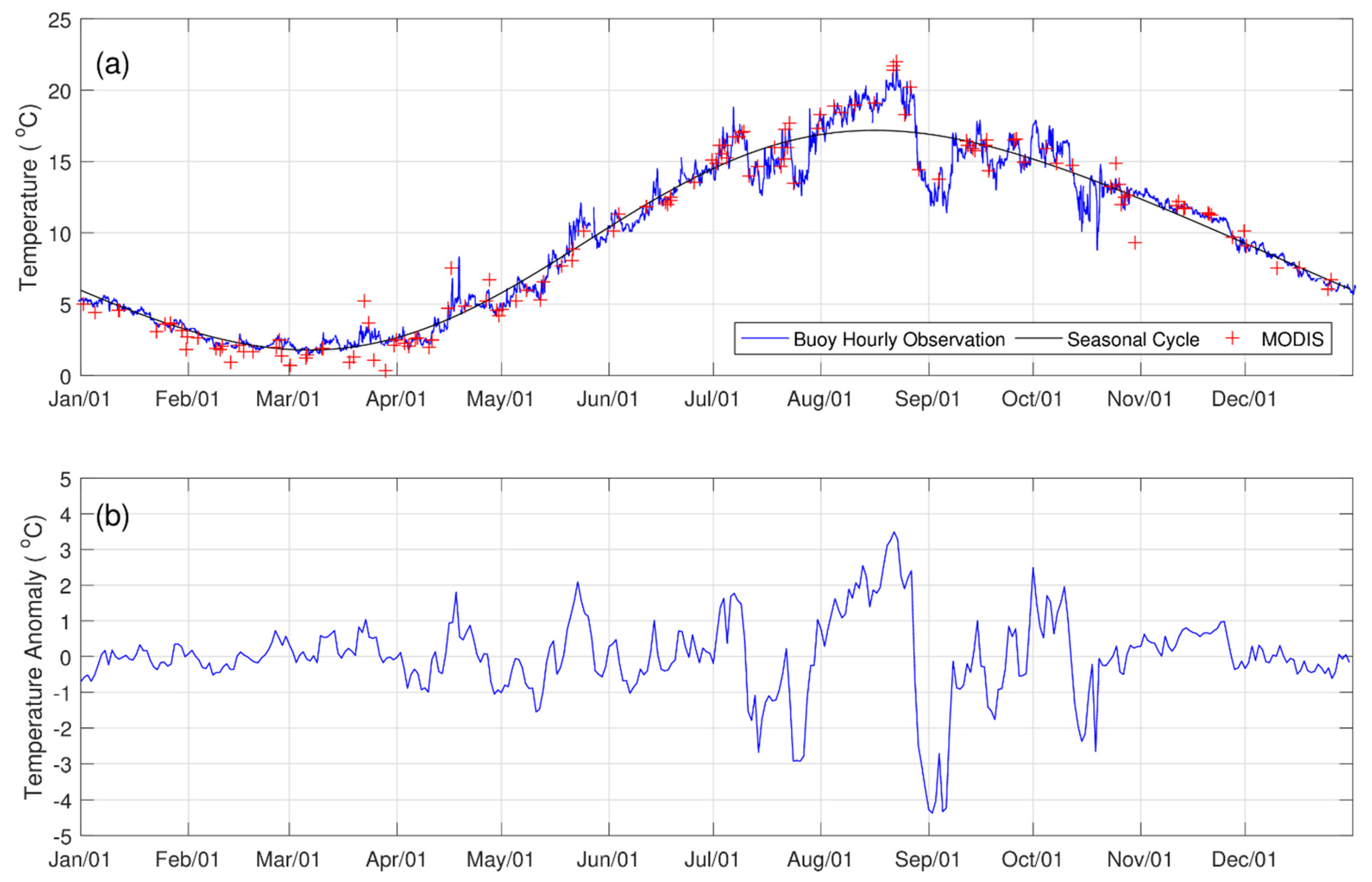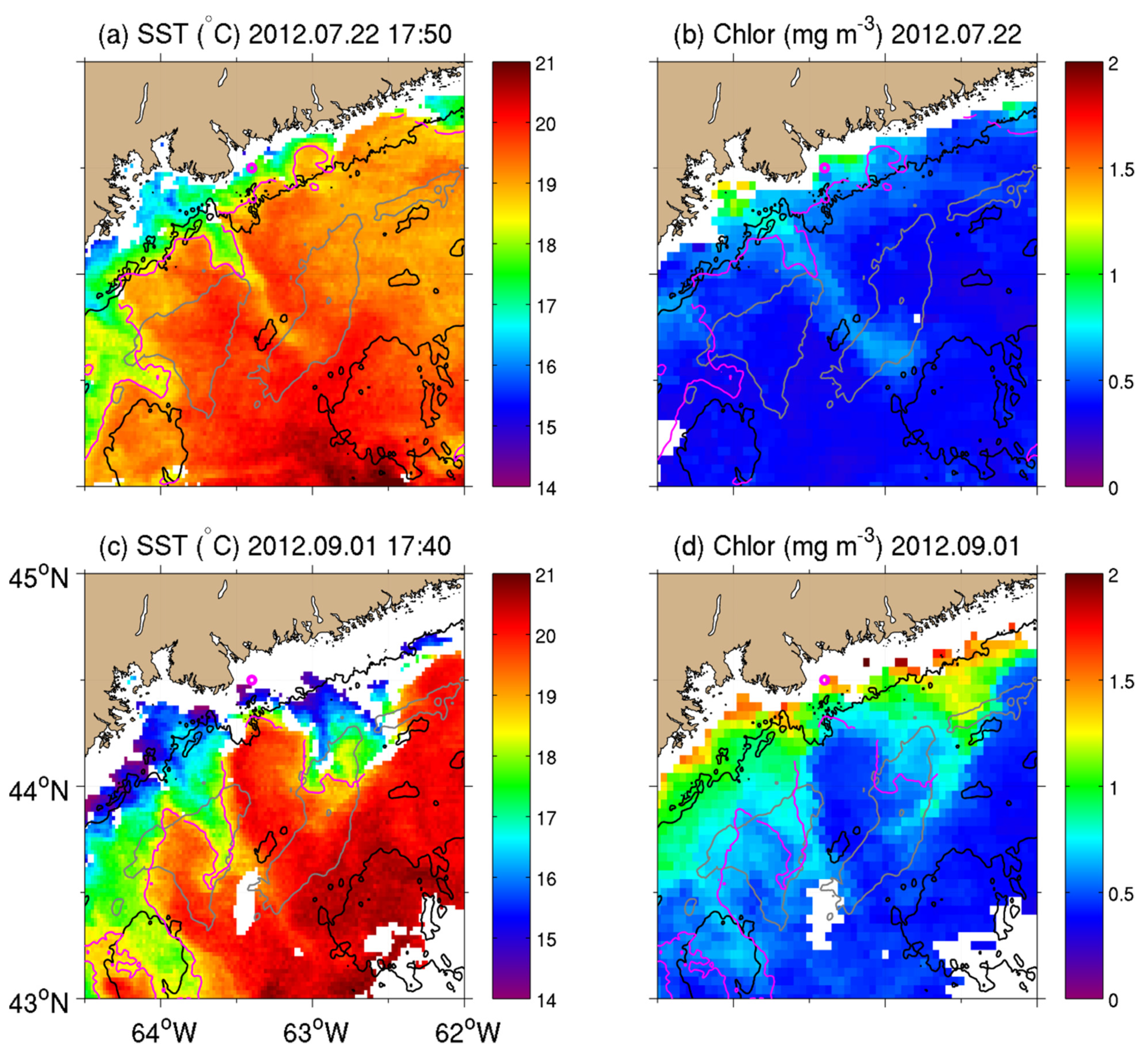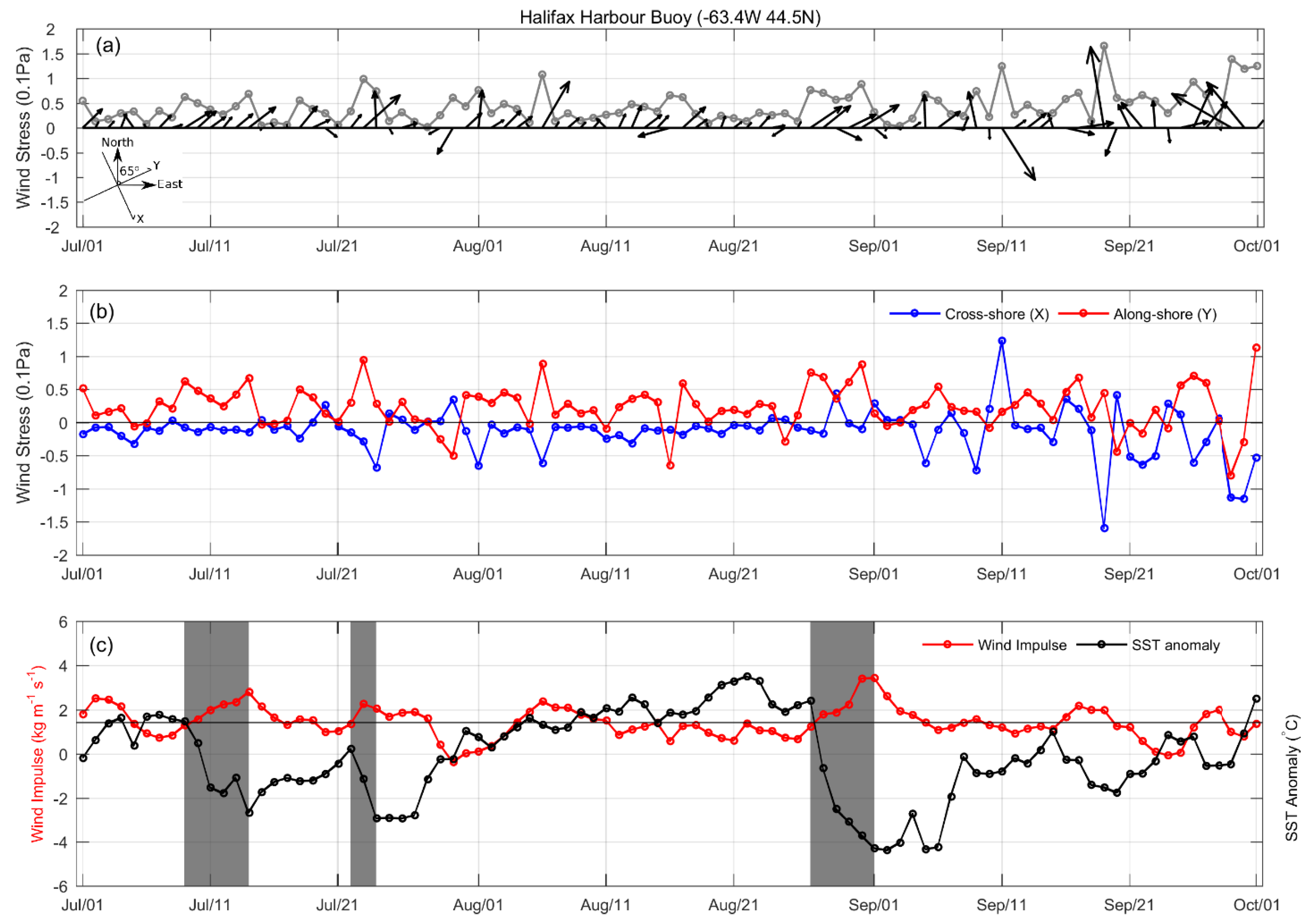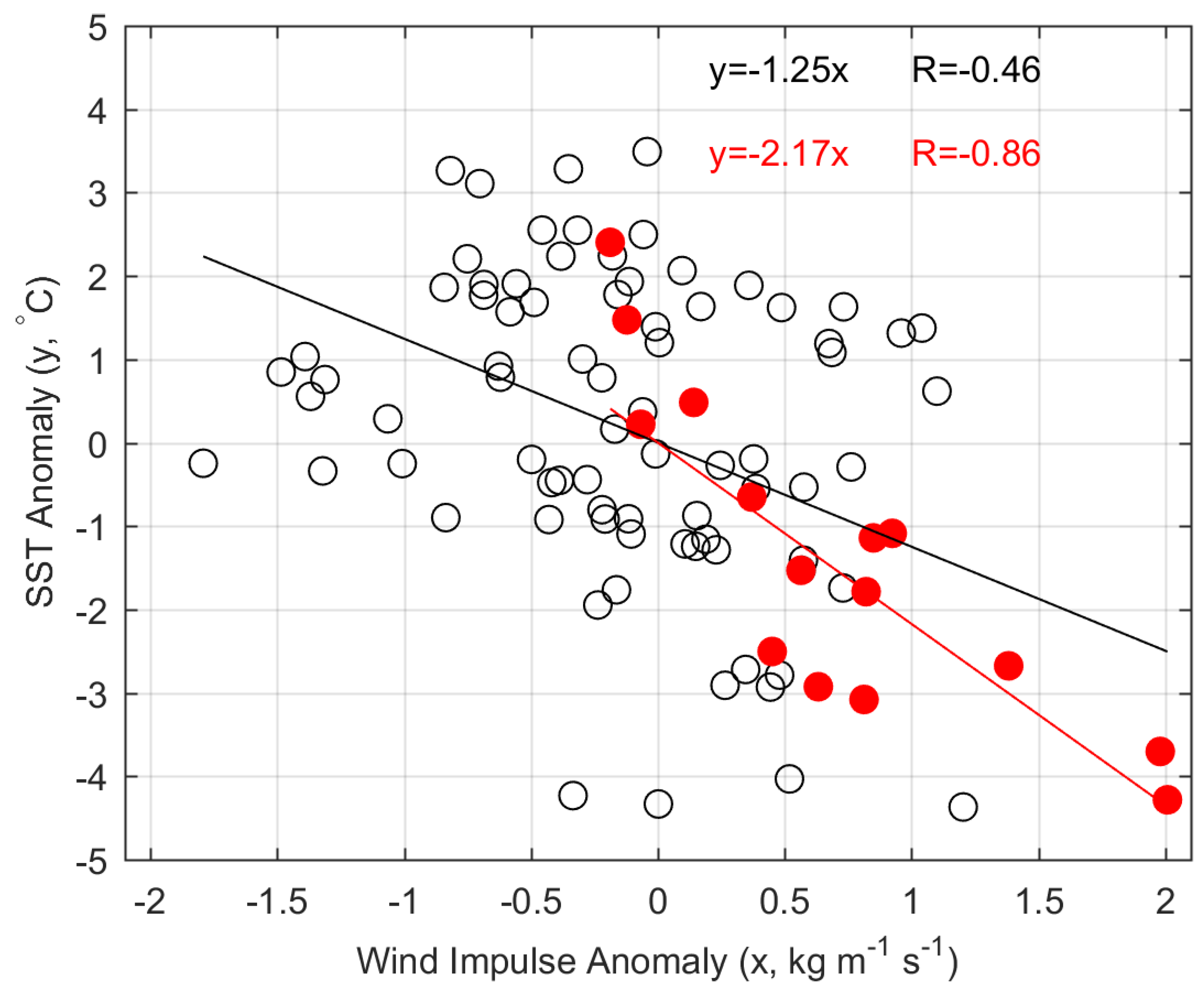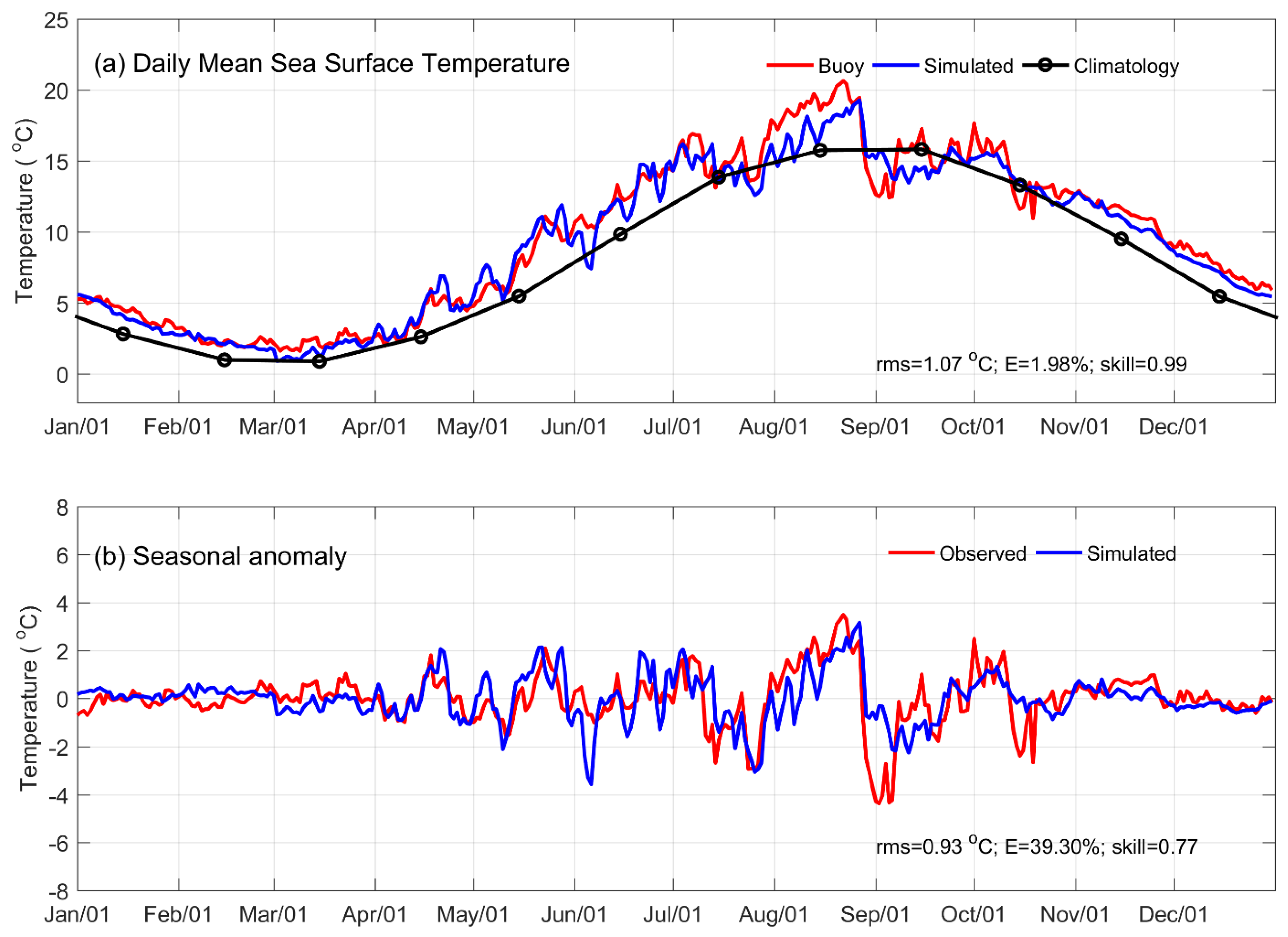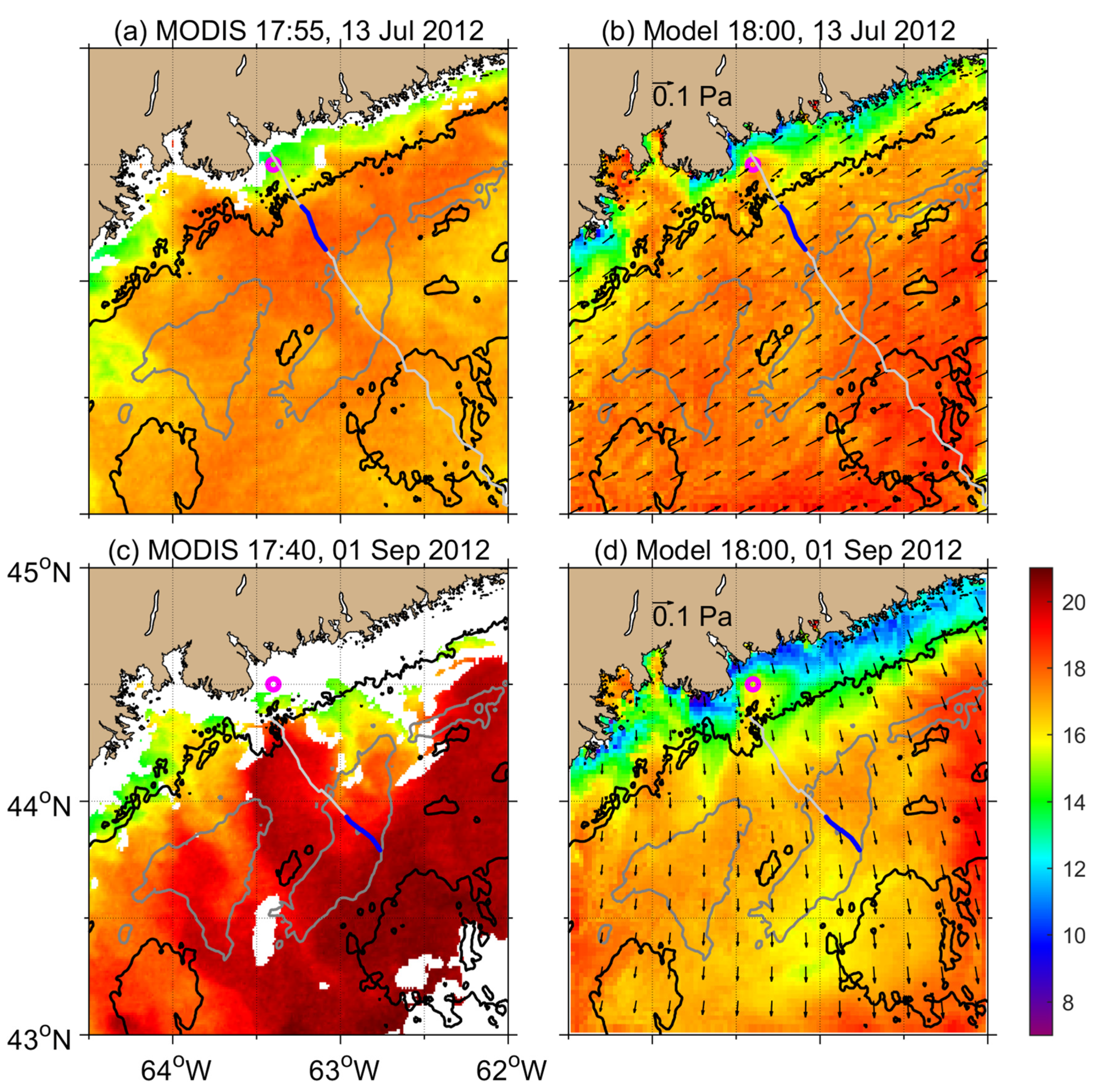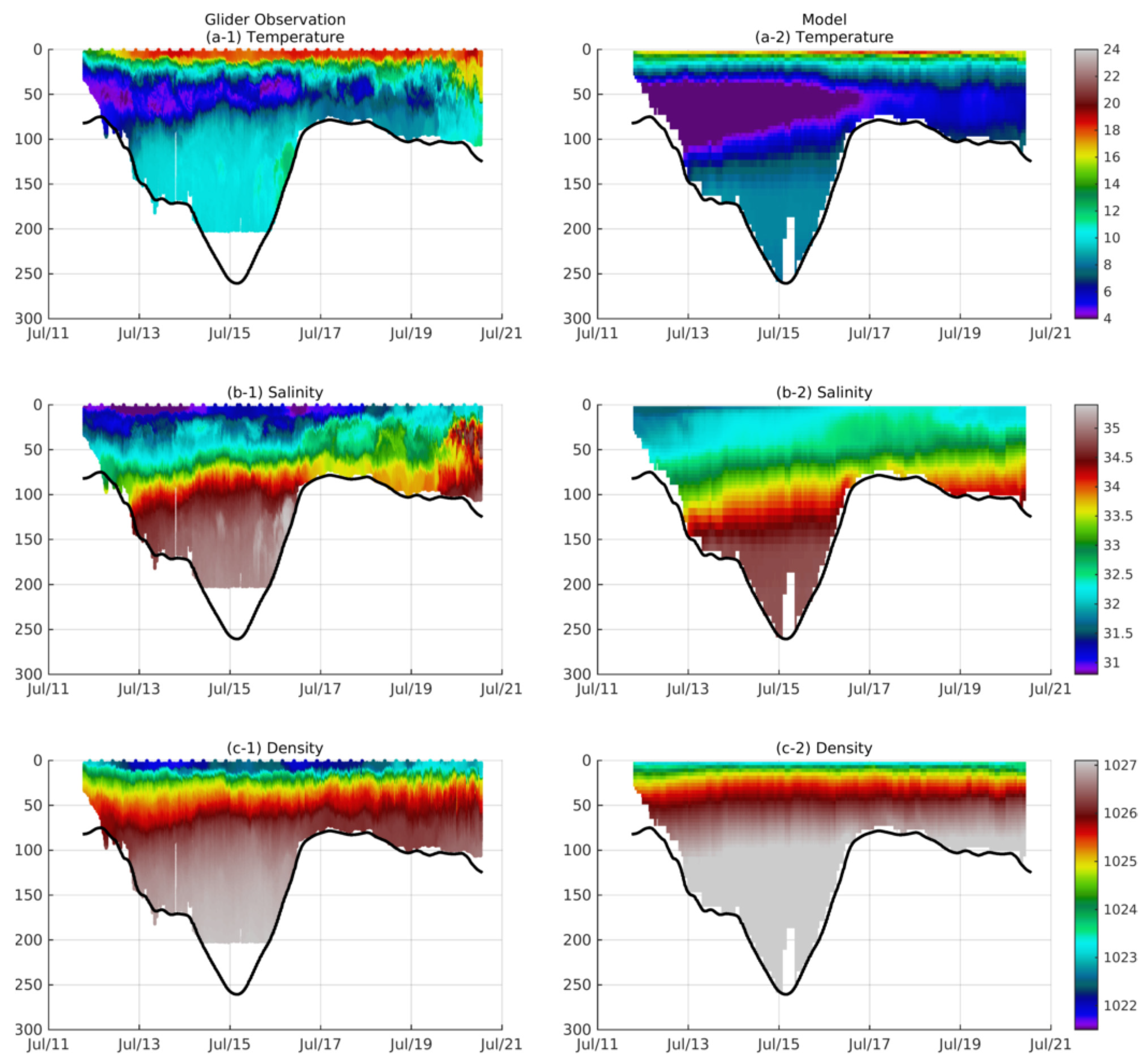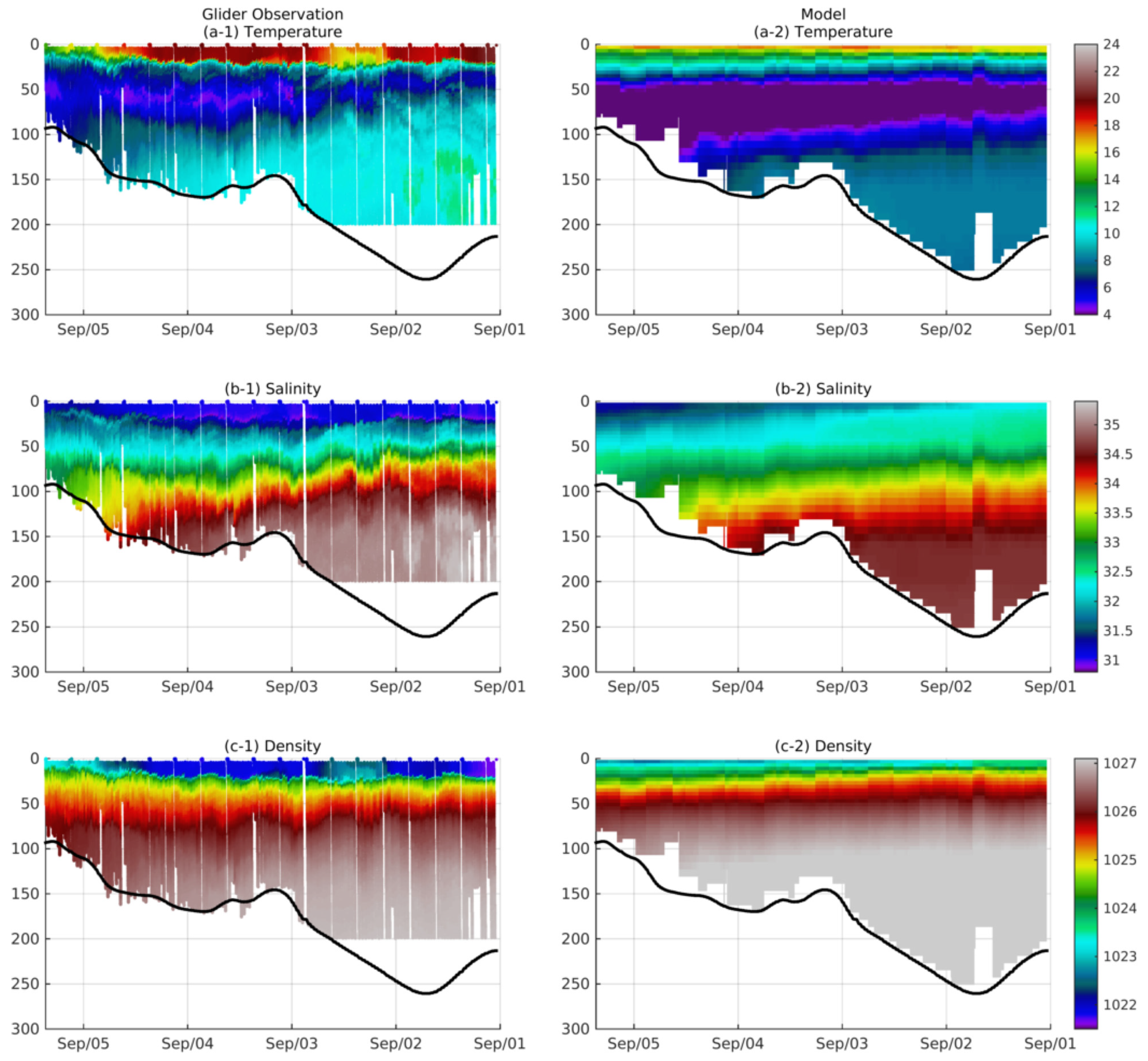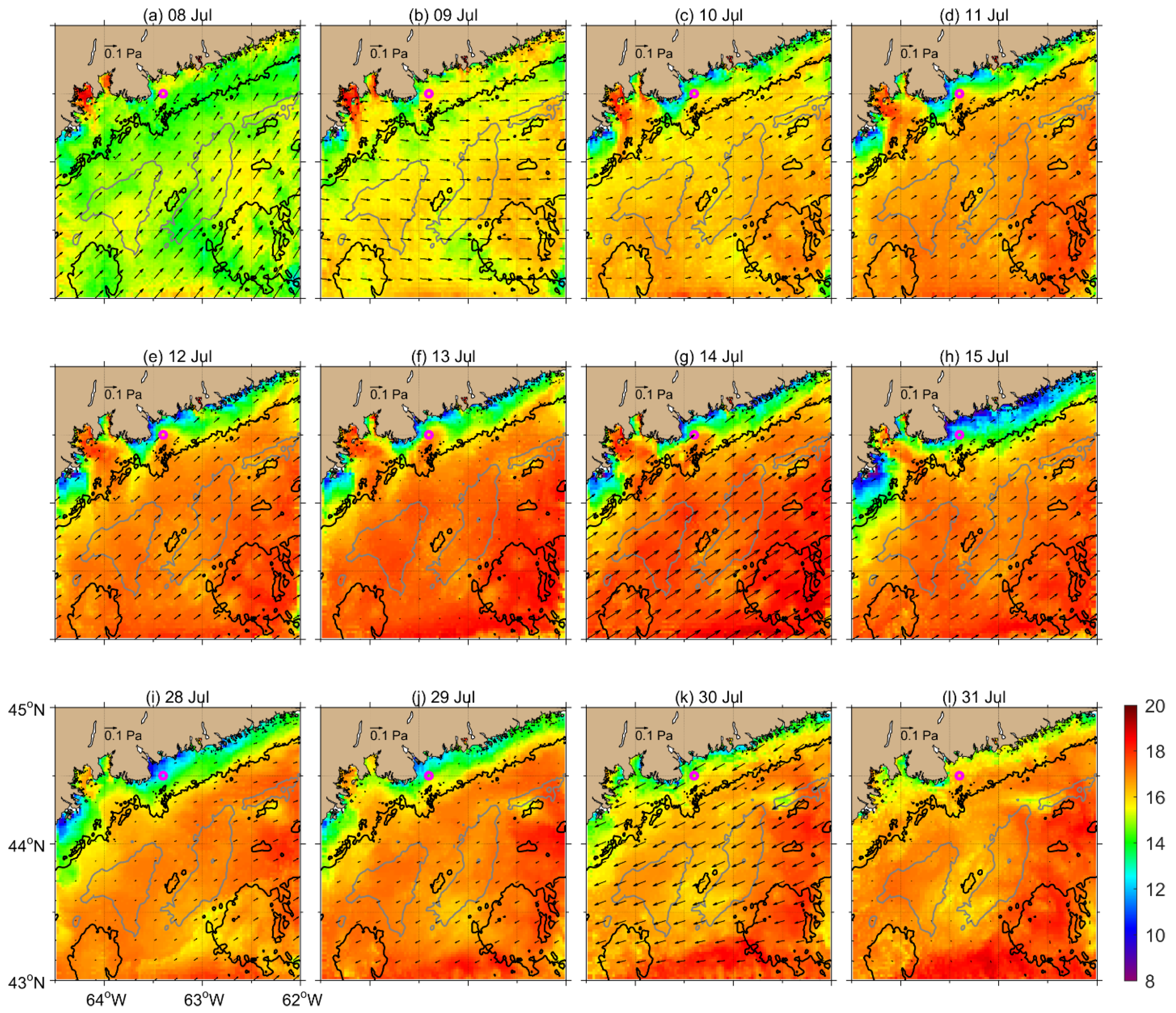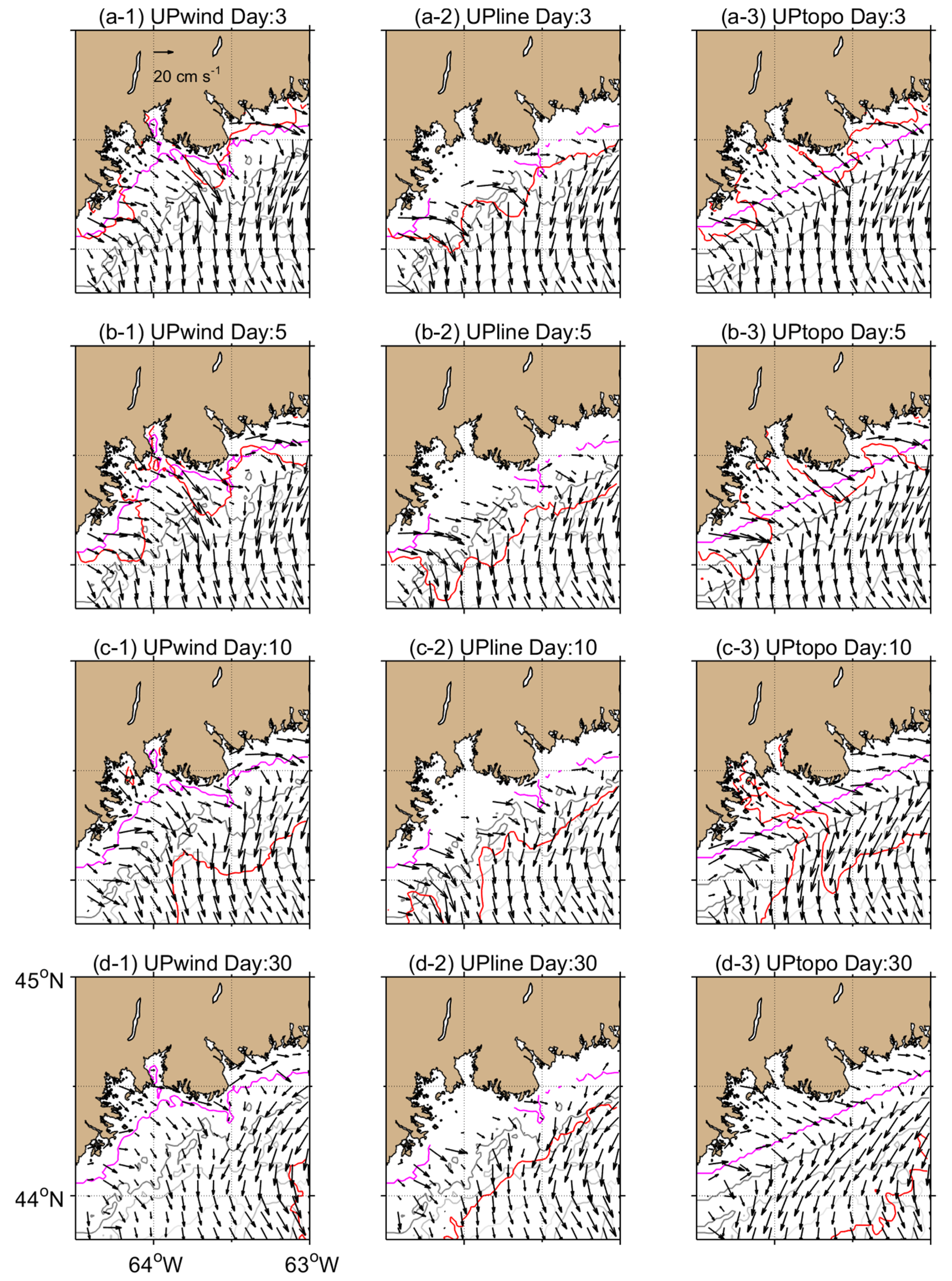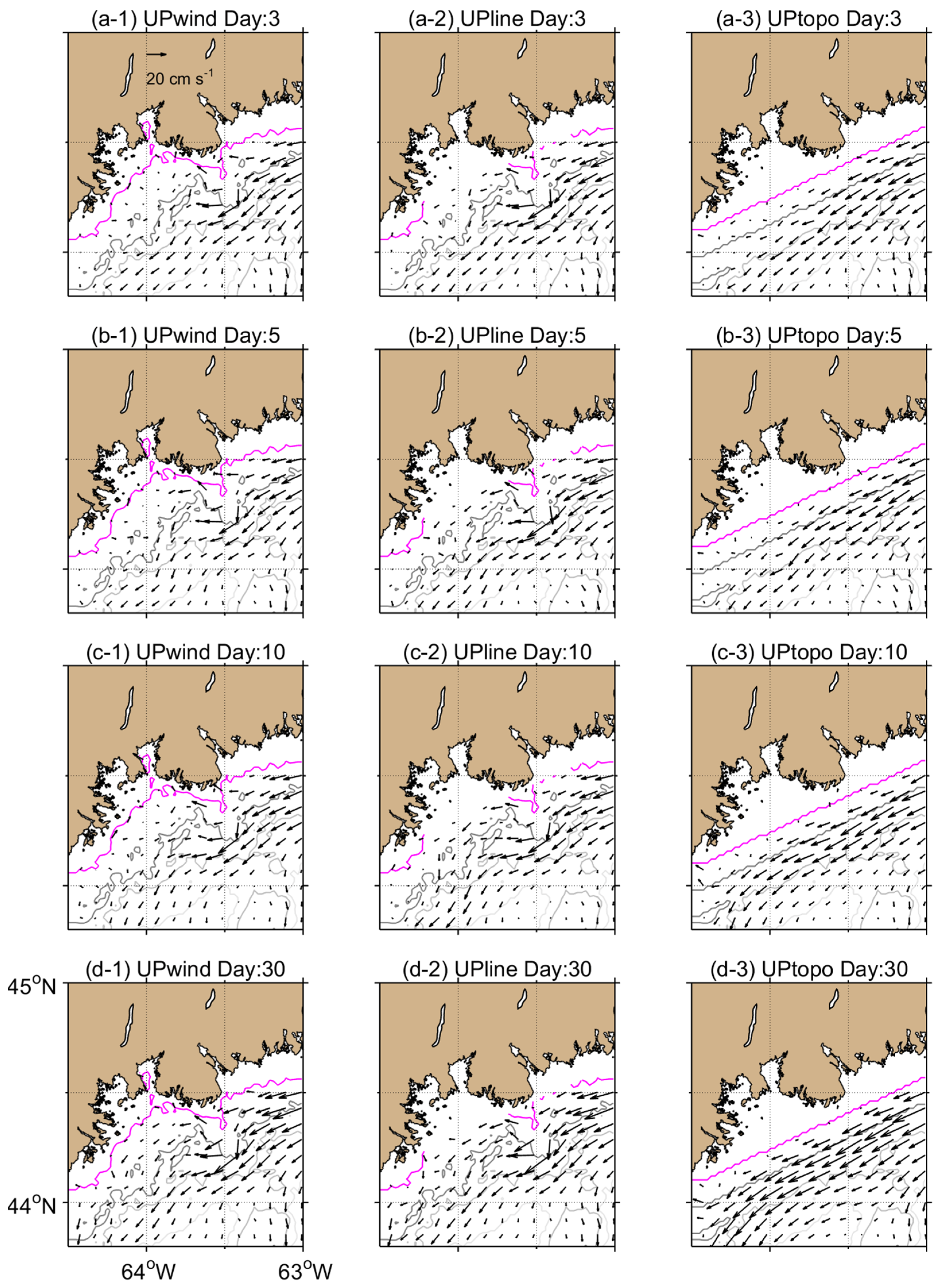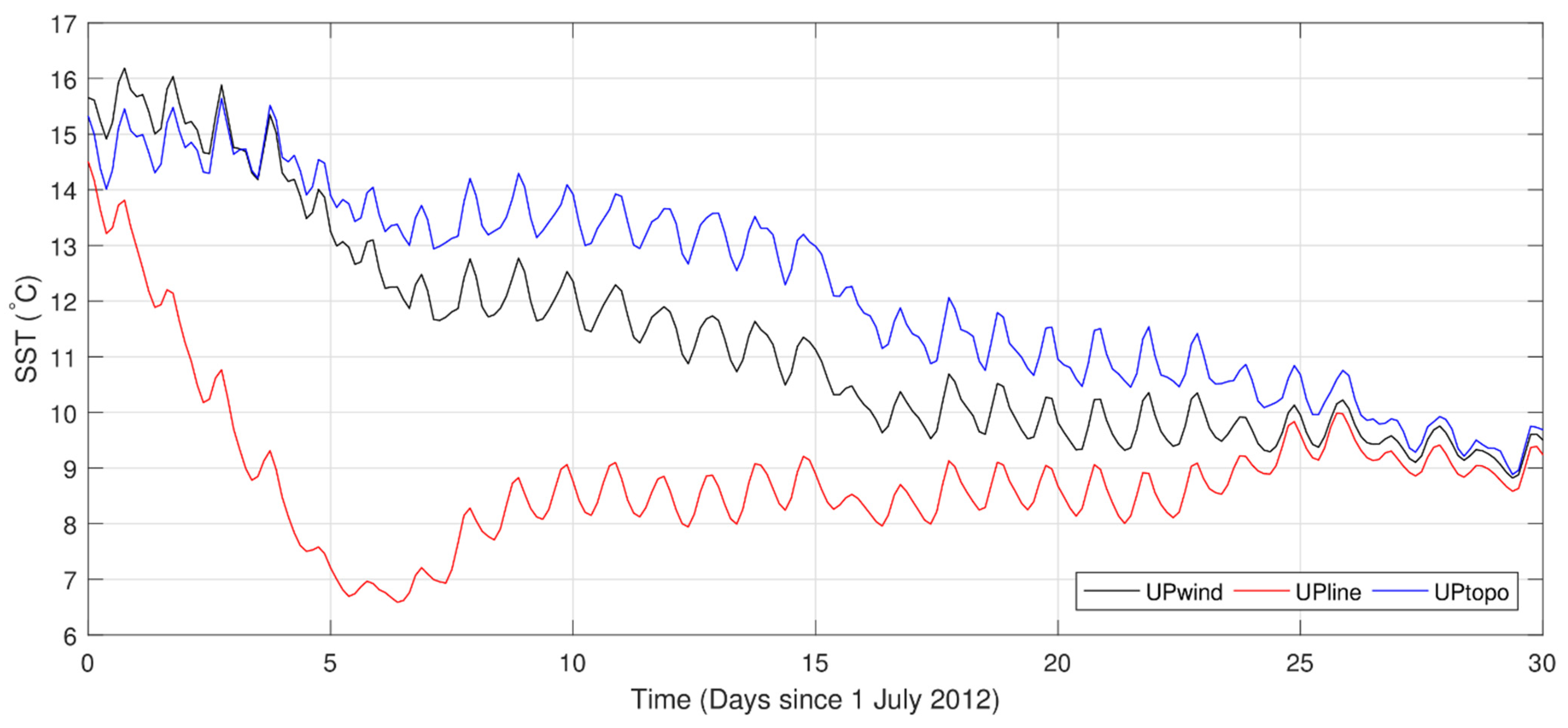4.1. Comparison of Model Results with Observations
The simulated SSTs produced by submodel L3 of DalCoast-CSS are first compared with the in-situ observations made at location HHb outside Halifax Harbour (marked in
Figure 1d).
Figure 7a demonstrates that submodel L3 reproduces reasonably well the observed seasonal cycle of the SSTs at HHb, with the lowest value of simulated SSTs being about 2.0 °C at the beginning of March and the highest value being about 20.0 °C near the end of August in 2012 (
Figure 7a). The lowest and highest values of SSTs at HHb produced by submodel L3 agree well with the in-situ observations.
Figure 7a also presents the monthly mean SST climatology (black curve) at HHb calculated from hourly SST observations at this site for the 14-year period (2000–2013). The seasonal cycles of simulated and observed SSTs at HHb in 2012 are similar to each other, and both of them are warmer than the 14-year SST climatology.
To provide a quantitative measure of the model performance, we compute the following statistical measures [
28]: the root-mean-square (rms) error defined as
the relative average error defined as
and the model skill parameter defined as
where
and
denote the observed and modelled variables respectively,
denotes the time mean of observed variable, and
denotes the number of observations. For the skill parameter, perfect agreement between the model results and observations yields a skill of one, whereas complete disagreement yields a skill of zero. The values of
and
are relatively small for the daily mean time series of SSTs, and the skill parameter is close to 1 (
Figure 7a), indicating that submodel L3 performs well in simulating the daily mean observed SSTs at HHb.
Submodel L3 is also able to reproduce very well the high-frequency (weather-band) variability of observed SSTs, particularly during the wind-driven upwelling events, with the
= 0.93 °C,
E = 39.3%, and the skill parameter equals 0.77 (
Figure 7b). Both the observed and simulated SST anomalies at HHb have relatively small anomalies in winter, early spring and late fall seasons, and relatively large in late spring, summer, and early fall seasons in 2012 (
Figure 7b). In particular, submodel L3 reproduces very well the observed SST anomalies during the upwelling events in July. The model also performs reasonably well in capturing the onset of the upwelling at the end of August. Submodel L3, however, underestimates the magnitude of the cooling of this upwelling event.
It should be noted that the four submodels of DalCoast-CSS are prognostic without data assimilation of real-time observations. The small rms errors for both the daily mean time series and seasonal anomalies of simulated SSTs indicate that the net heat flux calculation, vertical mixing parameterization, coastal currents, and advection of different water masses around HHb are satisfactory and adequate in the nested-grid modelling system.
We next examine the performance of submodel L3 of DalCoast-CSS in reproducing the observed spatial variations of SSTs.
Figure 8 presents a comparison of simulated SSTs with MODIS SST data over the central ScS at two specific times with relatively cloud-free conditions associated with the first and third major upwelling events in summer 2012. At 18:00 on 13 July 2012, the general horizontal patterns of the simulated coastal upwelling plume near the coast of Nova Scotia agree very well with satellite remote sensing SST data. The model also reproduces the along-shore variability of observed SSTs, particularly relatively warm SSTs in St. Margarets Bay, Mahone Bay, and adjacent coastal waters (
Figure 8a,b). In the offshore deep waters of the central ScS, the simulated SSTs agree with the satellite SST data, which are relatively uniform and warm (>15 °C). As mentioned above, the circulation model is not data assimilative of real-time observations; thus, it is beyond the ability of the current version of the circulation model with the present spatial resolution to reproduce the cold water plume exactly at the observed locations. Therefore, the fact that the similar large-scale features in both the model results and remote sensing data indicates again the satisfactory model performance of submodel L3 of DalCoast-CSS.
Figure 8d demonstrates that at 18:00 on 1 September 2012, submodel L3 generates a broad band of cold waters over coastal waters of the central ScS due to persistent upwelling-favorable winds in late August. At this time, the MODIS satellite SST data are not available over most of the coastal waters of the central ScS. Nevertheless, some limited SST data available over coastal waters at this time confirm the broad band of cold waters near the coast associated with intensive coastal upwelling induced by winds (
Figure 8c). In the deep offshore waters of the central ScS, the simulated SSTs at this time are relatively uniform, but cooler than the satellite SSTs. It should be noted that Submodel L3 performs less well in simulating the observed filaments. Only small filaments are developed along the 100 m isobath in the model, in comparison with observed filaments extending ~100 km offshore (
Figure 8c,d). As stated above, it is a great challenge for a circulation model with the present spatial resolution to reproduce well the nonlinear instability of the observed cold upwelling plume. The other plausible reason is that the vertical and horizontal mixing in the model may be too large, which erodes the upwelling front and prevent the further growth of filaments.
To demonstrate the model performance in simulating vertical stratification, we compare vertical distributions of the simulated hydrography by submodel L3 along two cross-shelf transects with in-situ observations made by a glider on 13 July and 1 September, respectively, during the first and third major coastal upwelling events in summer 2012 (
Figure 9 and
Figure 10). The glider track is shown in
Figure 8. A comparison of vertical distributions of simulated and observed temperatures shown in
Figure 9 and
Figure 10 demonstrates that DalCoast-CSS reproduces reasonably well the observed three-layer structure in the vertical with a cold intermediate layer (CIL) occurring at depths between about 25 and 100 m in summer months. The formation of the CIL is mainly due to winter convection, wind-driven mixing in the previous winter and advection of upstream cold high-latitude water by the Nova Scotia Current [
29]. It should be noted that the simulated warm surface layer is too thin and the CIL is too thick in the model in comparison with the glider observations. The thick CIL in the model could be related to the insufficient warm Slope Water intrusion at the shelf break in the model, which is likely due to the climatological open boundary conditions of temperature, salinity and currents specified in submodel L2. The thick CIL in turn reduces the thickness of the warm surface layer in the model through vertical mixing. The other possible reason is that the model resolution is too coarse to resolve the glider observed small-scale and high-frequency vertical variability along the thermocline.
A comparison of simulated and observed salinity distributions shown in
Figure 9 and
Figure 10 demonstrates that submodel L3 also reproduces reasonably well the relatively low salinity water associated with the Nova Scotia Current in the top 100 m and the relatively high salinity (>34.5) water in the deep layer (>100 m) of the Emerald Basin. However, the submodel L3 overestimates the salinity in the top 50 m, which could be explained by (1) the lack of freshwater input from small local rivers along the coast of Nova Scotia, and (2) the simple treatment of precipitation and evaporation processes at the sea surface in DalCoast-CSS.
Figure 9 demonstrates that the simulated isopycnals tilt upward towards the coast (
Figure 9(c-2)), which is similar to the observations (
Figure 9(c-1)) during the major upwelling events in July. The upward tilted isopycnals are a direct result of the secondary circulation associated with coastal upwelling, which brings deeper denser water masses up to shallower areas.
4.2. Model Results during Upwelling/Downwelling Events
Figure 11 presents distributions of instantaneous SSTs produced by submodel L3 of DalCoast-CSS at 12 different times during the major upwelling/downwelling events in July 2012. For the first coastal upwelling event from 8 to 11 July 2012 (top panels of
Figure 11), the along-shore winds during this period are upwelling-favorable (black arrows,
Figure 11a). The SSTs produced by submodel L3 are relatively uniform and about 14 °C over the middle and outer ScS (beyond the 100-m isobath along the coastline)
, except for 16 °C over some isolated areas. The simulated SSTs during this 4-day period increase from about 15 °C to 18 °C due to the positive net heat flux at the sea surface from the atmosphere to the ocean. On 8 July, the SSTs near the coast (from coastline to the 100 m isobath) are relatively uniform and about 15 °C, which is similar to the SSTs on the Shelf. On 9 July, relatively low SSTs occur over two coastal areas: one is to the west of Halifax Harbour and the other to the west of Mahone Bay. In the next two days (10 and 11 July), the simulated SSTs over these two coastal areas further decrease to less than 10 °C. In addition, relatively low SSTs also occur over the coastal area to the northeast of Halifax Harbour in these two days (
Figure 11c,d). From 12 to 15 July (middle panels of
Figure 11), the wind forcing is mainly southwesterly (upwelling-favorable) and the wind impulse is peaked on 14 July (
Figure 5c), leading to continuous development of coastal upwelling and significant offshore expansions of the low SST waters from coastal areas. It should be noted that the coastal upwelling plumes are not evident in St. Margarets Bay and Mahone Bay, indicating that the spatially varying development of coastal upwelling plume in the along-shore direction due to effects of local topography and coastline [
30], even though the wind forcing is spatially uniform during this period (
Figure 11e–h).
The bottom panels of
Figure 11 present the simulated SSTs and wind vectors during a downwelling event from 28 to 31 July. Significant upwelling cold water plume occurs on 28 and 29 July over the inner ScS, except for slightly warmer SSTs in St. Margarets Bay and Mahone Bay and adjacent coastal waters (
Figure 11i,j). On 30 July, the surface wind forcing used in DalCoast-CSS is mainly northeasterly (downwelling-favorable). The low SST areas near the coast are decreased under downwelling-favorable winds (
Figure 11k) and the SSTs near the coast are relatively uniform on 31 July except for coastal waters (
Figure 11l).
The general patterns of wind-driven coastal upwelling and downwelling near the coast of Nova Scotia shown in
Figure 11 are qualitatively consistent with previous studies (e.g., [
4]). In addition, the model is also able to capture the along-shore variations of the simulated SSTs using the relatively spatially uniform reanalysis wind over the central ScS, with warmer waters in St. Margarets Bay and Mahone Bay, which will be examined in the following section.
4.3. Process Study: Role of Irregular Coastline and Rugged Bathymetry
Model results and satellite SST observations discussed above demonstrate well that the wind-driven coastal upwelling over coastal waters of the central ScS has significant along-shore variability. In a theoretical study on the effects of topographic variations on coastal upwelling, Song and Chao [
30] demonstrated that significant along-shore variation of upwelling fronts is caused by the combined effect of local topography and stratification. The correlation analysis of observed SSTs in summer presented in
Section 3 (
Figure 4) statistically shows a decorrelation of SSTs in St. Margarets Bay and Mahone Bay from the SSTs in the upstream. The simulated SST fields during a major coastal upwelling event in July 2012 (
Figure 11) indicate that the surface waters in St. Margarets Bay and Mahone Bay are warmer than the adjacent coastal waters, which are consistent with the asymmetric pattern determined from the observational analysis.
There are significant bathymetric irregularities (i.e., Cape Sambro and Sambro Ledges) to the northeast (upstream) of St. Margarets Bay and Mahone Bay. To investigate the role of the irregular coastline and rugged bathymetry on the wind-driven coastal-upwelling over coastal waters of the central ScS, three additional numerical experiments are conducted using various specifications of coastline and nearshore bathymetry in submodel L3 of DalCoast-CSS:
Experiment using constant wind forcing (
UPwind): The DalCoast-CSS in this experiment is driven by the suite of forcing functions discussed in
Section 2.2, including tides, river discharges, atmospheric forcing, and open boundary forcing, except that typical upwelling-favorable wind stress (0.05 Pa and 65°T) is specified in submodel L2 and L3.
Experiment using straight coastline (UPline): Same as UPwind, except that the realistic irregular coastline in submodel L3 is replaced by a straight one.
Experiment using smoothed topography (UPtopo): Same as UPwind, except that the realistic rugged bathymetry near the coast (e.g., Sambro Ledges, a submerged bank associated with Cape Sambro) in submodel L3 is replaced by a smoothed topography, in which the isobaths from 50 to 100 m adjacent to the coast are parallel to each other and have an angle of 65°T.
In these three additional experiments (i.e.,
UPwind,
UPline and
UPtopo), submodels L2 and L3 are initialized from the 3D circulation and hydrography fields produced by the realistic hindcast run on 30 June 2012. It should be noted that in
UPtopo, topography smoothing in submodel L3 created a few model grids beyond the realistic maximum depth, and the temperature and salinity of those new grids are initialized by the near-bottom temperature and salinity from the realistic hindcast. Both L2 and L3 are integrated for one month. The model results of SST and circulation fields at 3, 5, 10, and 30 days after 1 July 2012 in the three numerical experiments (
Figure 12,
Figure 13 and
Figure 14) are examined to determine the effects of irregular coastline and rugged bathymetry on the coastal upwelling and associated spatial variability on the central ScS.
Model results in
UPwind demonstrate that a coastal upwelling plume develops under the constant upwelling-favorable wind condition (left panels of
Figure 12). After 3 days from the onset of the uniform wind forcing (
Figure 12(a-1)), three filaments with relatively low SST waters are developed near the coast in the model, with one located to the west of Mahone Bay (Filament A,
Figure 12(a-1)), one off the Cape Sambro (Filament B), and one at about 80 km to the northeast of Cape Sambro (Filament C). These three filaments extend about 50 km offshore on day 3. The SSTs to the northeast and southwest of Filament B are relatively warm and about 15 °C in this case. On day 5 (
Figure 12(b-1)), the three filaments in
UPwind are further extended offshore. On day 10 (
Figure 12(c-1)), Filament A in
UPwind is further extended offshore, and Filaments B and C are merged into a cold water band near the coast, and St. Margarets Bay is covered by relatively cold surface waters associated with the upwelling plume. The SST in Mahone Bay on day 10 is warmer than the SST inside the upwelling plume but colder than the SST on the Shelf. The SSTs over the middle and outer shelf increase from about 15 °C to 18 °C, mainly due to the positive surface heat flux from the overlying atmosphere to the ocean. On day 30 in
UPwind (
Figure 12(d-1)), Filament A is extended to LaHave Bank, and Mahone Bay is completely covered by relatively cold surface water associated with the upwelling plume. Backward breaking waves associated with the instability at the plume front [
31] are evident along the 100 m isobath to the northeast of Sambro Ledges (
Figure 12(d-1)). It should be noted that the steady along-shore wind for 30 days is an idealized extreme case and the associated widely-spread low SST water band over the inner ScS in
Figure 12(d-1) is not very common on the ScS.
The coastal upwelling plume along a straight coastline produced by submodel L3 in
UPline (middle panels of
Figure 12) has several distinct features in comparison with the plume in
UPwind. On day 3, three filaments are also evident along the straight coastline in
UPline (
Figure 12(a-2)). In comparison with the filaments in
UPwind, the filaments in
UPline extend further offshore. The filament close to Cape Sambro (Filament B) in
UPline is located further southwest compared to the one in
UPwind. On day 5 (
Figure 12(b-2)), the filaments in
UPline extend further offshore, and Filament B moves closer to Filament A, which is located to the west of Mahone Bay. On day 10, Filament B is merged with Filament A to form a larger filament (
Figure 12(c-2)). Another filament is developed off Cape Sambro on day 10 (
Figure 12(c-2)). On day 30, the upwelling plume is very similar to the plume in
UPwind. Backward breaking waves associated with the instability at the plume front are also developed along the 100 m isobath to the northeast of Sambro Ledges (
Figure 12(d-2)). The southwestward propagation of the filament from Cape Sambro in the straight coastline is not evident based on model results of
UPwind, which indicates that the cape has a scattering effect for the along-shore wave propagation of the filaments.
The coastal upwelling plume in
UPtopo, in which Sambro Ledges are removed, has similar features near the coast but distinct features in the offshore deep waters in comparison with the plume in
UPwind. On day 3, 5, and 10, the coastal upwelling plume from the coast to the 50 m isobath in
UPtopo is very similar to the plume in
UPwind, indicating that the presence of Sambro Ledges has a minor effect on the initial development of the filaments near the coast. On day 10, the cold upwelling plume is evident along the coast except for the areas outside St. Margarets Bay and Mahone Bay. At day 30, backward breaking waves associated with the instability at the plume front are developed along the 150 m isobath from northeast to southwest in
UPtopo (
Figure 12(d-3)), while the instability waves are disrupted by the presence of Sambro Ledges in
UPwind (
Figure 12(d-1)).
In addition to the SST fields, the circulation fields adjacent to Sambro Ledges at two depths (near-surface and ∼50 m) in three additional experiments are also examined (
Figure 13 and
Figure 14). For the near-surface circulation on day 3 in
UPwind two regimes are evident from the coast to the middle shelf of the central ScS. The first regime is the coastal region with the local water depths less than 50 m. In this region, the near-surface currents are eastward or southeastward mainly due to the upwelling-favorable wind forcing. The second regime is the offshore region beyond the 50 m isobath. Over this region, the currents are significantly modified by the southwestward buoyancy-driven Nova Scotia Current. In
UPwind on day 3 and 5, a relatively strong offshore current associated with the edge of the upwelling plume (12 °C isotherm in
Figure 13(a-1),(b-1)) occurs in the lee of Sambro Ledges. On day 10 and 30, the currents in the lee of Sambro Ledges are reduced as the edge of the upwelling plume moves further offshore. In
UPline, the relatively strong offshore currents in the lee of Sambro Ledges are not evident during the 30-day period. In
UPtopo, the Nova Scotia Current on day 10 and 30 penetrates further to the southwest due to the absence of Sambro Ledges. For the circulation at 50 m (
Figure 14), the influence of Sambro Ledges is more evident compared to the near-surface circulation fields (
Figure 13). In these three additional experiments, the main subsurface circulation feature is the Nova Scotia Current, which flows southwestward following the 150 m isobath along the coast. In
UPwind and
UPline, offshore and onshore flows are evident to the northeast and southwest of Sambro Ledges due to local topographic steering. In
UPtopo, however, the Nova Scotia Current is not deflected since Sambro Ledges are removed, and the currents to the southwest (downstream) of Sambro Ledges are relatively stronger in
UPtopo than the currents in
UPwind.
We next examine the temporal variability of area-averaged SSTs over St. Margarets Bay, Mahone Bay, and adjacent coastal waters (
Figure 15) in the three additional numerical experiments. The diurnal surface heating is evident in these three experiments. The sub-diurnal SST responses can be categorized into two periods: (1) the initial response period (first 4 days) and (2) the continued response period (after 4 days). It should be noted that the time-scale of the initial response (∼4 days) in these three experiments is comparable to the initial response period of a typical realistic upwelling-favorable wind event (gray vertical bars in
Figure 5c). In
UPwind, initially the area-averaged SSTs oscillate around 15.5 °C. After day 4, the area-averaged SSTs decrease with time to ∼9.5 °C on day 30. In
UPline, the area-averaged SSTs are significantly different from the SSTs in
UPwind during the 30-day period. The sub-diurnal SSTs in
UPline feature a rapid linear drop from 14.5 °C to ∼7 °C during the first 5 days and a gradual increase to about ∼9.5 °C during the following 25 days. In
UPtopo, the area-averaged SSTs are only significantly different from the SSTs in
UPwind during the continued response period. The temperature difference between
UPtopo and
UPwind increases from nearly 0 at day 4 to a maximum of ~2 °C on day 15, and then decreases to ~0.2 °C on day 30. The effect of irregular coastline and rugged bathymetry on the time-dependent response of SSTs during upwelling events can be summarized as follows. First, the differences (similarities) of SSTs in
UPwind and
UPline (
UPtopo) in the initial response period support the idea that the irregular coastline is the main controlling factor for the observed relatively warm SSTs in St. Margarets Bay and Mahone Bay during the initial response period. Secondly, the similarities and differences of SSTs in
UPwind and
UPtopo in the initial and continued response periods, respectively, suggest that the small-scale rugged bathymetry has less effect on the SST variation in the initial response period, but plays an important role in the SST variations in the continued response period. Lastly, the results from the three experiments also suggest that the influence of irregular coastline and rugged bathymetry on the SSTs in the two Bays is reduced towards the end of the month, at which time the upwelling plume has been fully-developed.

